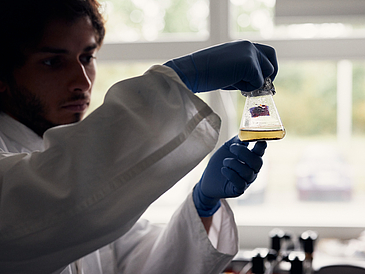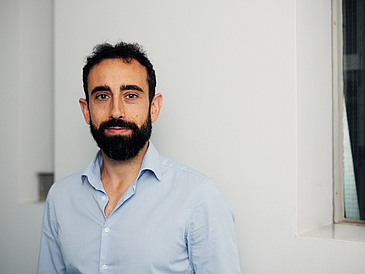Article from Vanessa Roolfing, University of Bremen, translation by Katie Lorenz.
Scientists Dr. Cyprien Verseux and Prof. Dr. Sven Kerzenmacher from the University of Bremen are working on solutions for self-sufficiency on Mars – and how these could inspire sustainable life on Earth.
On Earth, we usually breathe almost automatically – it is only in moments of physical exertion or in crowded lecture halls that we realize just how important air is for us. But on Mars, where there is no atmosphere to enable natural breathing, the production of oxygen becomes a central challenge. Not only oxygen, but also many other vital resources become scarce on Mars. The idea of bringing everything needed for long-term survival along from Earth may sound appealing at first – like packing a backpack for a trip. However, experts quickly dismiss such an approach as not only uneconomical, but also simply impossible for missions that last more than a few years. Therefore, it is crucial to find ways to produce as much as possible on site from the naturally available resources on Mars. Bremen scientists Prof. Dr. Sven Kerzenmacher from the Center of Environmental Research and Sustainable Technology (UFT) and Dr. Cyprien Verseux from the Center for Applied Space Technology and Microgravity (ZARM) are tackling this challenge as part of the “Humans on Mars” initiative in the “Sustainable Bioproduction on Mars” project.
Survival Starts with Cyanobacteria
Cyprien Verseux’s research is based on the use of cyanobacteria, one of the oldest life forms on our earth. These organisms could feed on gases from the Martian atmosphere and regolith, the top loose layer on Mars, and produce oxygen. Regolith contains elements such as calcium, magnesium, and iron, which stimulate the growth of the bacteria. However, these nutrients must first be extracted from the Martian soil, which is not without risks. This is due to the fact that regolith contains toxic compounds, especially perchlorates. The Martian soil is therefore both a source of nutrients and toxic compounds and must be handled with appropriate care. Cyprien Verseux has already demonstrated in the Laboratory of Applied Space Microbiology (LASM) at ZARM that the concept of oxygen production with the help of cyanobacteria using resources found on Mars can work. He is investigating how the bacteria can be developed to optimally absorb the resources of Mars.
Another complexity in dealing with cyanobacteria on Mars is that although they can use the gases present in the Martian atmosphere as a source of carbon and nitrogen, this atmosphere would have to be reprocessed to a certain extent. Verseux’s team is therefore examining how changes in atmospheric parameters affect bacterial growth and looking for a compromise between minimal processing of the atmosphere and efficient bacterial growth. This is crucial because processing these gases consumes resources, which are known to be scarce on Mars. Verseux emphasizes the relevance of comprehensive research to estimate not only the feasibility, but also the efficiency and the costs. “Knowing it can work is not enough. You have to know how well it works and how cost-efficient the system is,” explains Verseux.
From By-product to Resource Treasure
The targeted research approach goes beyond pure oxygen production. Sven Kerzenmacher, an expert in application development and bioelectrochemical systems at UFT, focuses on making sensible use of the by-products of oxygen production – namely cyanobacterial biomass that contains essential nutrients such as phosphate and nitrogen as well as carbon compounds.
The scientist and his team at UFT primarily work on integrating various processes that allow the conversion of cyanobacteria and regolith by-products into valuable secondary products, such as biofuel and bioplastics. Kerzenmacher’s team defines the characteristics and requirements of this part of the process and optimizes the processing of the cyanobacteria biomass. In doing so, he keeps an eye on the larger perspective: “In our field of environmental process engineering, there is a special focus on the analysis of integrated processes. Our research goes beyond the development of materials and detailed insights – we want to capture the big picture and understand and shape the system holistically. This comprehensive perspective is also reflected in the diversity of our research group, which brings together researchers from the fields of microbiology, physics, chemistry, and mechanical engineering.” Kerzenmacher’s vision is to use biomass in an integrated process, such as in electrolysis cells for producing bioplastics or hydrogen. Organic carbon is removed from the mixture, and the remaining product, a solution of nitrogen and phosphate, could in turn serve as fertilizer for plants in greenhouses on Mars. This is another step in the process for sustainable bioproduction on Mars. This part of the project is being pursued primarily by Dr. Daniel Schubert at the German Aerospace Center (Deutsches Zentrum für Luft- und Raumfahrt; DLR).
A Vision for Mars and Earth
The cooperation between disciplines and institutes brings Verseux and Kerzenmacher together for collaborative work for the first time. Sven Kerzenmacher particularly appreciates the interdisciplinarity of “Humans on Mars.” He says: “Cyprien and I knew each other before, visited each other’s labs and saw that there were overlapping areas. However, the initial decision to work together came within the framework of the initiative. This makes ‘Humans on Mars’ a wonderful opportunity for me to work with a lot of colleagues or to get together and exchange ideas.”
This exchange brings researchers together to not only explore partial aspects of bioproduction processes, but to comprehensively develop a closed loop system that uses Mars as an autonomous resource. The goal of collaborative research is to make the best use of a very limited number of resources. In this approach lies the potential for space exploration to not only expand human boundaries, but also inspire solutions for sustainable life on Earth, thus addressing the issues of our time.
Read full article here at auf up2date, the online magazine from University of Bremen.



